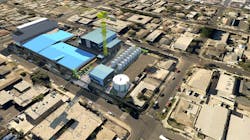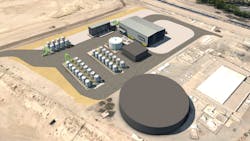LOS ANGELES, CA -- The Kiewit-Stantec design-build team recently broke ground on two multi-year projects that together total $400 million and will help remediate water from the San Fernando Valley Groundwater Basin (SFB) for the Los Angeles Department of Water and Power (LADWP). The SFB covers 226 square miles northwest of downtown Los Angeles.
The new state-of-the-art facilities at the North Hollywood Central Response Action Treatment Facility and Tujunga Well Field Response Action Treatment Facility will address historical groundwater contamination from post WWII and cold-war era industrial operations in the area. The projects include new pretreatment automatic backwash strainers, 10 largest-of-their-kind ultraviolet advance oxidation process reactors, 54 13,000-gallon granular activated carbon units, 12 miles of pipe, and nearly 250 miles of electrical cable.
The state-of-the-art projects are part of LADWP’s remedial actions for the Rinaldi-Toluca and Tujunga operable units. Remediation and restoration of beneficial uses of this portion of the basin will protect public health, and in turn support utilizing LADWP’s annual water rights and goals to reduce imported water dependence. Once fully restored, the SFB can provide drinking water to more than 800,000 Angelenos. LADWP is completing these two projects pursuant to the Comprehensive Environmental Response, Compensation, and Liability Act (CERCLA), commonly known as Superfund.
Today, local groundwater provides approximately 11% of the City’s total water supply. It has provided more than 20% of the City’s total supply in some drought years. The City gets most of its water from the Los Angeles Aqueduct—which is Eastern Sierra snowmelt — and from the California Aqueduct, which is water from the Sacramento/San Joaquin River Delta.




